Martin B-57 Canberra Video - Great Planes - B-57 Canberra - Part 1
|
|
Martin B-57 Canberra
B-57 Canberra
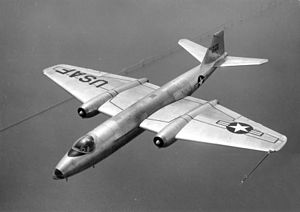
Picture - B-57A in flight over Chesapeake Bay, Maryland
Role: Bomber
Manufacturer: Martin
First flight: 20 July 1953
Introduced: 1954
Status: Retired (2 still used by NASA)
Primary users: United States Air Force
Pakistan Air Force
Republic of China Air Force
Number built: 403
Unit cost: US$1.26 million (B-57B)
Developed from: English Electric Canberra
The Martin B-57 Canberra was a United States-built, twin jet engine light bomber and reconnaissance aircraft, which entered service with the United States Air Force (USAF) in 1953. The B-57 was initially a version of the English Electric Canberra built under license. However, the Glenn L. Martin Company significantly modified the design and produced several unique variants.
The world's last two remaining flight worthy WB-57s reside at NASA Johnson Space Center in Houston, TX as high altitude scientific research aircraft.
Development
At the outbreak of the Korean War in 1950, the USAF found itself in dire need of an all-weather interdiction aircraft. The piston-engined Douglas A-26 Invaders were limited to daytime and fair weather operations and were in short supply. Consequently, on 16 September 1950, the USAF issued a request for a jet-powered bomber with a top speed of 630 mph (1,020 km/h), ceiling of 40,000 feet (12,190 m), and range of 1,150 miles (1,850 km). Full all-weather capability and secondary reconnaissance role had to be included in the design. To expedite the process, only projects based on existing aircraft were considered. The contenders included the Martin XB-51, and the North American B-45 Tornado and AJ Savage.
Foreign aircraft including the Canadian Avro Canada CF-100 Canuck and the new Canberra which had not officially entered service with the Royal Air Force (RAF) at the time, were also considered, an extremely rare move. The AJ and B-45 were quickly dismissed because their outdated designs had limited growth potential. The CF-100, an all-weather interceptor, was too small and lacked sufficient range. The XB-51, while very promising and much faster, had limited maneuverability, a small weapons bay and limited range and endurance.
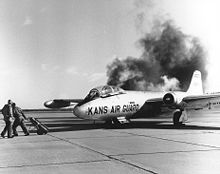
Picture - Cartridge engine starters in an RB-57B producing copious amounts of black smoke
On 21 February 1951, a British Canberra B.2 (flown by Roland Beamont) became the first-ever jet to make a non-stop unrefuelled flight across the Atlantic Ocean, arriving in the United States for USAF evaluation. In a 26 February flyoff against the XB-51, the Canberra emerged a clear winner. It was officially taken up by the USAF on 25 May 1951.
However, because their production lines were working at full capacity to meet the Royal Air Force orders, English Electric was unable to produce additional aircraft quickly enough for USAF requirements, and on 3 April 1951, Martin was granted a license to build Canberras, designated B-57 (Martin Model 272) in the United States. To expedite production, the first B-57As were largely identical to the Canberra B.2, with the exception of more powerful Armstrong Siddeley Sapphire engines of 7,200 lbf (32 kN) of thrust instead of Rolls-Royce Avons, also license-built in the United States as Wright J65s. In addition, canopy and fuselage windows were slightly revised, the crew was reduced from three to two, wingtip fuel tanks were added, engine nacelles were modified with additional cooling scoops, and the conventional "clamshell" bomb bay doors were replaced with a low-drag rotating door originally designed for the XB-51.
The first production aircraft flew on 20 July 1953, and was accepted by USAF on 20 August 1953. During the production run from 1953 to 1957, a total of 403 B-57s were built.
Operational history
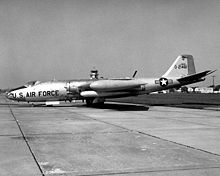
Picture - EB-57A parked at Scott AFB, 1969.
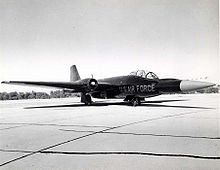
Picture - B-57E with nose graft from Bomarc, for testing of the missile.
The B-57A was not considered combat-ready by the USAF and the aircraft were used solely for testing and development. One of the aircraft was given to the National Oceanic and Atmospheric Administration (NOAA) which fitted it with a new nose radome and used it to track hurricanes. The reason for such limited production was that the distinctly British B-57A was considered unfit for USAF service. Particularly contentious were the odd cockpit arrangement and the lack of guns, the British Canberra having been designed as a high-speed, high altitude bomber rather than for close air support. The definitive B-57B introduced a new tandem cockpit with a bubble canopy, the engines were now started with a pyrotechnic cartridge, the airbrakes were moved from the wings to the sides of the fuselage for increased effectiveness, the controls were now boosted, four hardpoints were fitted under the wings, and the aircraft was given gun armament in the form of 8 x 0.50 in (12.7 mm) Browning machine guns in the wings, later replaced by 4 x 20 mm M39 cannons. The first B-57B flew on 18 June 1954. The aircraft initially suffered from the same engine malfunctions as the RB-57As and several were lost in high-speed low-level operations due to a faulty tailplane actuator which caused the aircraft to dive into the ground. The USAF considered the B-57B inadequate for the night intruder role and Martin put all aircraft through an extensive avionics upgrade. Regardless, by the end of 1957 the USAF tactical squadrons were being re-equipped with supersonic F-100 Super Sabres. The complete retirement was delayed, however, by the start of the Vietnam War.
Reconnaissance B-57s
While the USAF found the B-57A lacking, the photo reconnaissance RB-57A saw some operational use. First flying in October 1953, RB-57As fully equipped the 363rd Tactical Reconnaissance Wing at Shaw Air Force Base by July 1954. The aircraft were also deployed with USAF squadrons in Germany, France, and Japan. However, operational readiness was poor and the aircraft suffered from significant production delays because of engine problems. Wright had subcontracted production of J65 engines to Buick, which resulted in slow deliveries and a tendency for engine oil to enter the bleed air system, filling the cockpit with smoke. The problems were ameliorated when Wright took over engine production in 1954. RB-57As also suffered from a high accident rate caused in part by poor single-engine handling. This resulted in the entire fleet spending much of 1955 on the ground. By 1958, all RB-57A craft were replaced in active service by the Douglas RB-66B and McDonnell RF-101A. Air National Guard units extensively used the RB-57A for photographic surveys of the United States until 1971.
Two RB-57As were used by the Republic of China Air Force for reconnaissance missions over China; one was shot down by a Chinese Mikoyan-Gurevich MiG-17 on February 18, 1958 and the pilot killed. In 1959, two RB-57Ds were delivered to replace the A-types; one of them was shot down over China by a SA-2 Guideline missile, marking the very first successful operational engagement of surface-to-air missiles. Two other RB-57As were used by the Federal Aviation Administration to plan high-altitude airways for the upcoming jet passenger aircraft.
A number of RB-57s were used by the 7499th Support Group at Wiesbaden in "Heart Throb" reconnaissance missions over Europe.
Starting in 1959, Martin began to modify retired RB-57As with electronic countermeasures (ECM) equipment in the bomb bay. Redesignated EB-57A, these aircraft were deployed with Defense Systems Evaluation Squadrons which played the role of aggressors to train the friendly air defense units in the art of electronic warfare. Subsequent bomber variants were also modified to fulfill this role.
Strategic Air Command employed 20 RB-57D aircraft from 1956 until 1964. Little is known about their use. The aircraft were retired due to structural fatigue and the advent of the U-2 and SR-71.
Vietnam War
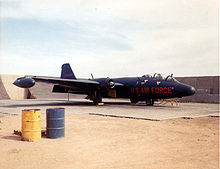
Picture - Patricia Lynn RB-57E at Da Nang, January 1964
Though intended as a bomber and never before deployed by the USAF to a combat zone, the first B-57s to be deployed to South Vietnam were not operated in an offensive role. The need for additional reconnaissance assets, especially those capable of operating at night, led to the deployment of two RB-57E aircraft on 15 April 1963. Under project Patricia Lynn these aircraft provided infrared coverage using their Reconofax VI cameras. Later in August 1965, a single RB-57F would be deployed to Udon, RTAB in an attempt to gather information about North Vietnamese SAM sites, first under project Greek God and then under project Mad King. In December another RB-57F would be deployed for this purpose, under project Sky Wave. Neither project garnered useful results and they were terminated in October 1965 and February 1966 respectively.
The deployment of actual combat capable B-57Bs from 8th and 13th Bomb Squadrons to Bien Hoa in August 1964 began with three aircraft lost in collisions on arrival. An additional five aircraft were destroyed with another 15 damaged by a Viet Cong mortar attack in November of the same year. Low level sorties designated as training flights were conducted with the hope of it having a psychological effect. As a result the first combat mission was only flown on 19 February 1965. The first excursion into North Vietnam took place on 2 March as part of Operation Rolling Thunder. The aircraft typically carried 9 x 500 lb (227 kg) bombs in the bomb bay and 4 x 750 lb (340 kg) bombs under the wings. In April, Canberras began flying night intruder missions supported by C-123 Provider or C-130 Hercules flare ships and EF-10B Skyknight electronic warfare aircraft.
On 16 May 1965, an armed B-57B exploded on the runway at Bien Hoa, setting off a chain reaction that destroyed 10 other Canberras, 11 Douglas A-1 Skyraiders, and one Vought F-8 Crusader. Due to combat attrition, in October 1966, B-57Bs were transferred to Phan Rang where they supported operations in the Iron Triangle along with Australian Canberra B.20s. The aircraft also continued to fly night interdiction missions against the Ho Chi Minh trail. Of the 94 B-57Bs deployed to Southeast Asia, 51 were lost in combat and seven other Canberras were lost to other causes. Only nine were still flying by 1969.
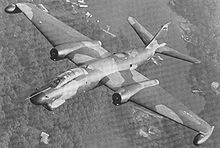
Picture - Tropic Moon III B-57G with FLIR/LLLTV pod on the left nose
B-57s returned to Southeast Asia in the form of the Tropic Moon III B-57G, deployed to Thailand during the fall of 1970. Intended as a night intruder to help combat movement along the Ho Chi Minh trail, these aircraft were equipped with a variety of new sensors and other equipment, and were capable of dropping laser guided munitions. The relative kill rates per sortie during Operation Commando Hunt V between the B-57G and the AC-130A/E showed that the former was not as suited to the role of trucker hunter. An attempt to combine both led to one B-57G being modified to house a special bomb bay installation of one Emerson TAT-161 turret with a single M61 20mm cannon as a gunship under project Pave Gat. Poor results led to this system not being produced and the prototype was not deployed to the theatre. The B-57G was removed from Thailand in May 1972. Plans remained for the continuation of the B-57G program but post-conflict spending cuts forced the abandonment of these plans.
For a short period South Vietnamese Air Force personnel operated four B-57B aircraft. The VNAF never officially took control of the aircraft, and, after accidents and other problems, including apparent claims by VNAF pilots that the B-57 was beyond their physical capabilities, the program was terminated in April 1966, and the aircraft were returned to their original USAF units.
Pakistan
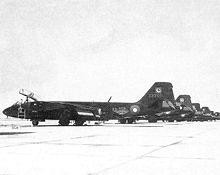
Picture - PAF B-57s
The Pakistan Air Force was one of the main users of the B-57 and made use of it in two wars with India. In the Second Kashmir War of 1965 B-57s flew 167 sorties, dropping over 600 tons of bombs. Three B-57s were lost in action, along with one RB-57F electronic intelligence aircraft. However, only one of those three was lost as a result of enemy action. During the war, the bomber wing of the PAF was attacking the concentration of airfields in north India. In order to avoid enemy fighter-bombers, the B-57s operated from several different airbases. The B-57 bombers would arrive over their targets in a stream at intervals of about 15 minutes, which Pakistani authors believe, led to achieving a major disruption of the overall IAF effort.
During the Indo-Pakistani War of 1971, the PAF again made use of the B-57. On the very first night, 12 IAF runways were targeted and a total of 183 bombs were dropped. As the war progressed, PAF B-57s carried out many night missions. There was a higher attrition rate than in 1965, with at least five B-57s being put out of service by the end of the war. They were retired from service in the PAF in 1985.
Variants
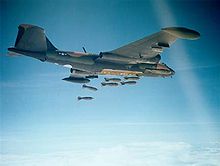
Picture - USAF B-57 dropping 750 lb (340 kg) bombs
B-57A
First production version; eight built.
B-57B
Definitive production version, tandem cockpit, 8x 0.50 in (12.7 mm) machine guns or 4x 20 mm cannons, four underwing hardpoints; 202 built.
B-57C
Dual-control trainer, first flight: 30 December 1954; 38 built.
B-57E
Target tug, first flight: 16 May 1956; 68 built.
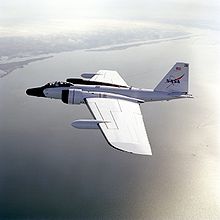
Picture - A WB-57F flies over the Gulf of Mexico near its base at NASA JSC.
B-57G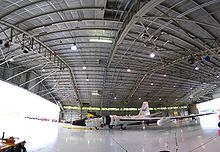
Picture - Panorama of Ellington field's hangar 990, with one of the two WB-57Fs inside.
Photo reconnaissance version with cameras installed aft of the bomb bay; 67 built.Operators
![Airplane Picture - English Electric Canberra (dark blue) and B-57 (light blue) operators[18]](images/1-images113010/350px-Cranberry_operators.png)
Picture - English Electric Canberra (dark blue) and B-57 (light blue) operators[18]
Pakistan
Pakistan Air Force
Republic of China
Republic of China Air Force
United States
United States Air Force
NASA
NCAR/High Altitude Mapping Missions, Inc,
National Oceanic and Atmospheric Administration of the United States Commerce Department
Survivors
Section source: AeroWeb RB-57A Photo reconnaissance
AF Ser. No. 52-1467 and 52-1446 Glenn L. Martin Maryland Aviation Museum, Middle River, Maryland
AF Ser. No. 52-1492 at the Hill Aerospace Museum at Hill AFB, Utah. In April 1968, this aircraft was delivered to the National Museum of the United States Air Force at Wright-Patterson AFB in Dayton, Ohio, and was displayed there until 1982.
AF Ser. No. 52-1475 at the Museum of Aviation at Robins AFB, Georgia
AF Ser. No. 52-1488 at the New England Air Museum, Windsor Locks, Connecticut
AF Ser. No. 52-1485 and 52-1456 at the Selfridge Military Air Museum and Air Park, Selfridge ANGB, Michigan
AF Ser No. 52-1482 at the USAF History and Traditions Museum, Lackland AFB, San Antonio, Texas
AF Ser. No. 52-7421 Yankee Air Museum Belleville, Michigan
EB-57B Electronics reconnaissance
AF Ser. No. 52-1504 at the Dyess Linear Air Park, Dyess AFB, Texas
AF Ser. No. 52-1526 at the Edward F. Beale Museum, Beale AFB, California
AF Ser. No 52-1509 at Laughlin AFB, Texas
AF Ser. No. 52-1505 at the Malmstrom AFB Museum, and Air Park, Malmstrom AFB, Montana
AF Ser. No. 52-1519 at the March Field Air Museum, March ARB, Riverside, California
AF Ser. No. 52-1548 at the South Dakota Air and Space Museum, Ellsworth AFB, Rapid City, South Dakota
AF Ser. No. 52-1516 at the Air Force Armament Museum at Eglin AFB, Florida
AF Ser. No. 52-1499 at the National Museum of the United States Air Force, Wright-Patterson AFB, Dayton, Ohio. This aircraft was assigned to Wright-Patterson Air Force Base in Dayton, Ohio as a test aircraft in the early 1960s. In 1965, it was returned to combat configuration to replace combat losses in Southeast Asia. It was assigned to the 8th Bomb Squadron at Phan Rang AB, South Vietnam in 1967, where it flew combat missions for 2½ years. Upon return to the United States, it was converted to an electronic countermeasures EB-57B and was flown to the museum in August 1981. It is on display in the Museum's Modern Flight gallery where it replaced an RB-57A (AF Ser. No. 52-1492) that had been on display at the Museum since April 1968.
AF Ser. No. 52-1500 is on display at the Vermont Air National Guard's Burlington ANGB (158th Fighter Wing) at Burlington International Airport in Burlington, Vermont
B-57B
AF Ser. No. 52-1576 is on display at the Air Force Flight Test Center Museum at Edwards AFB, California
AF Ser. No. 52-1584 is at the Kalamazoo Aviation History Museum, Kalamazoo, Michigan
RB-57D Photo reconnaissance
AF Ser. No. 53-3982 is on display at the National Museum of the United States Air Force at Wright-Patterson AFB in Dayton, Ohio. This is one of the 13 photo reconnaissance RB-57Ds. It is painted as it appeared in the late 1950s while serving in the 4025th Strategic Reconnaissance Squadron (L). It went on display in the Museum's Cold War gallery in 2004.
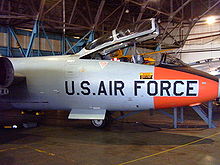
Picture - EB-57E at Wings Over the Rockies Museum, CO, 2007
EB-57E Electronics reconnaissance
AF Ser. No. 55-4253 is on display at the Castle Air Museum (former Castle AFB) in Atwater, California
AF Ser. No. 55-4279 is on display at the Peterson Air and Space Museum at Peterson AFB in Colorado Springs, Colorado
AF Ser. No. 55-4293 is on display at the Wings Over the Rockies Air and Space Museum, Lowry Campus (former Lowry AFB), Denver, Colorado
B-57E
AF Ser. No. 55-4274 is on display at the Pima Air and Space Museum adjacent to Davis-Monthan AFB in Tucson, Arizona
AF Ser. No. 55-4244 is on display at the Strategic Air Command Museum (adjacent to Offutt AFB), Ashland, Nebraska
WB-57F Weather reconnaissance
AF Ser. No. 63-13293 is on display at the Museum of Aviation at Robins AFB, Georgia
AF Ser. No. 61-13501 is on display at the Pima Air & Space Museum adjacent to Davis-Monthan AFB in Tucson, Arizona
Specifications (B-57B)
Data from Quest for Performance
General characteristics
Crew: 2
Length: 65 ft 6 in (20.0 m)
Wingspan: 64 ft 0 in (19.5 m)
Height: 14 ft 10 in (4.52 m)
Wing area: 960 ft² (89 m²)
Empty weight: 27,090 lb (12,285 kg)
Loaded weight: 40,345 lb (18,300 kg)
Max takeoff weight: 53,720 lb (24,365 kg)
Powerplant: 2x— Wright J65-W-5 turbojets, 7,220 lbf (32.1 kN) each
* Zero-lift drag coefficient: 0.0119
Drag area: 11.45 ft² (1.06 m²)
Aspect ratio: 4.27
Performance
Maximum speed: Mach 0.79 (598 mph, 960 km/h) at 2,500 ft (760 m)
Cruise speed: 476 mph (414 knots, 765 km/h)
Stall speed: 124 mph (108 knots, 200 km/h)
Combat radius: 950 mi (825 nm, 1,530 km) with 5,250 lb (2,380 kg) of bombs
Ferry range: 2,720 mi (2,360 nm, 4,380 km)
Service ceiling: 45,100 ft (13,745 m)
Rate of climb: 6,180 ft/min (31.4 m/s)
Wing loading: 42 lb/ft² (205 kg/m²)
Thrust/weight: 0.36
Lift-to-drag ratio: 15.0
Armament
Guns: 4x— 20 mm (0.787 in) M39 cannon, 290 rounds/gun
Bombs:
4,500 lb (2,000 kg) in bomb bay, including nuclear bombs
2,800 lb (1,300 kg) on four external hardpoints, including unguided rockets
Avionics
APW-11 Bombing Air Radar Guidance System
SHORAN bombing system
APS-54 Radar Warning Receiver
Related development
English Electric Canberra
Comparable aircraft
Avro CF-100
Ilyushin Il-28
Martin XB-51
North American AJ Savage
North American B-45 Tornado
Bibliography
Anderton, David A. BofAeE, AFAIA. "Martin B-57 Night Intruders & General Dynamics RB-57F". Aircraft in Profile, Volume 14. Windsor, Berkshire, UK: Profile Publications Ltd., 1974, pp. 1-25. ISBN 0-85383-023-1.
Drendel, Lou. Air War over Southeast Asia, Vol 1, 1962-1966. Carrolton, TX: Squadron/Signal Publications, Inc, 1982. ISBN 0-89747-134-2.
Hobson, Chris. Vietnam Air Losses, USAF/Navy/Marine, Fixed Wing Aircraft Losses in Southeast 1961-1973. North Branch, Minnesota: Specialty Press, 2001. ISBN 1-8578-0115-6.
Jones, Barry. "A Nice Little Earner". Aeroplane, Volume 34, Number 10, October 2006.
Knaack, Marcelle Size. Encyclopedia of U.S. Air Force Aircraft and Missile Systems: Volume II: Post-World War II Bombers, 1945-1973. Washington, DC: Office of Air Force History, 1988. ISBN 0-16-002260-6.
Mesko, Jim. VNAF, South Vietnamese Air Force 1945-1975. Carrolton, TX: Squadron/Signal Publications, Inc, 1987. ISBN 0-89747-193-8.
Mikesh, Robert. "Buy British, Fly American." Wings, October 1977.
Mikesh, Robert C. "Martin B-57 Canberra. The Complete Record". Atglen, PA: Schiffer Publishing Ltd., 1995. ISBN 0-88740-661-0.
Pfau, Richard A. and William H. Greenhalgh, Jr. FM B-57G - Tropic Moon III 1967-1972. Washington, DC: Office of Air Force History, Headquarters United States Air Force, 1978.
Smith, Mark E. USAF Reconnaissance in South East Asia (1961-66). San Francisco, CA: Headquarters, Pacific Air Force, Department of the Air Force, 1966.
Martin B-57 Canberra Pictures and Martin B-57 Canberra for Sale.
Living Warbirds: The best warbirds DVD series.
Source: WikiPedia